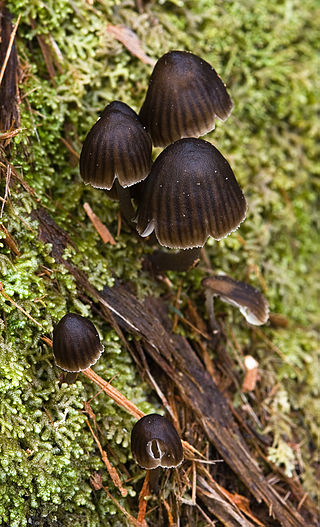
Mycena nargan, commonly known as the Nargan's bonnet, is a species of fungus in the family Mycenaceae, and the sole member of the section Nargan in the genus Mycena. Reported as a new species in 1995, it is known predominantly from Southern Australia. The saprobic fungus produces mushrooms that grow on well-decayed wood, often on the underside of wood lying in litter. The dark chestnut-coloured caps are covered with white, easily removed scales, and reach diameters of up to 2 cm (0.8 in) wide. The pale, slender stems are up to 5 cm (2.0 in) long and have white scales at the base. On the underside of the cap, the cream-coloured gills are widely spaced and bluntly attached to the stem. The edibility of the mushroom is unknown.

Mycena multiplicata is a species of mushroom in the family Mycenaceae. First described as a new species in 2007, the mushroom is known only from the prefecture of Kanagawa, Japan, where it grows on dead fallen twigs in lowland forests dominated by oak. The mushroom has a whitish cap that reaches up to 13 mm (0.51 in) in diameter atop a slender stem 15 to 20 mm long and 1 to 1.3 mm thick. On the underside of the cap are whitish, distantly spaced gills that are narrowly attached to the stem. Microscopic characteristics of the mushroom include the amyloid spores, the pear-shaped to broadly club-shaped cheilocystidia which are covered with a few to numerous, unevenly spaced, cylindrical protuberances, the lack of pleurocystidia, and the diverticulate hyphae in the outer layer of the cap and stem. The edibility of the mushroom is unknown.

Leucocoprinus ianthinus is a species of mushroom producing fungus in the family Agaricaceae. Like several other Leucocoprinus species it may have originated in a tropical climate but now finds a home in plant pots, greenhouses and compost piles in many countries. It is not seen in plant pots with the same kind of regularity as the well known Leucocoprinus birnbaumii and not seen in the wild as frequently as Leucocoprinus brebissonii.
Leucocoprinus straminellus is a species of mushroom producing fungus in the family Agaricaceae. Like other Leucocoprinus species it may have originated in a tropical climate but now finds a home in plant pots, greenhouses and compost piles in many countries. Leucocoprinus straminellus is described as being similar to the more commonly known Leucocoprinus birnbaumii but it is smaller and a lighter shade of yellow with smaller spores that lack a germ pore. It is also described as being superficially similar to Leucocoprinus fragilissimus but slightly more robust with flesh that is less translucent.
Leucocoprinus bakeri is a species of mushroom producing fungus in the family Agaricaceae.
Leucocoprinus austrofragilis is a species of mushroom producing fungus in the family Agaricaceae.
Leucocoprinus tropicus is a species of mushroom producing fungus in the family Agaricaceae.

Macrolepiota zeyheri is a species of mushroom producing fungus in the family Agaricaceae. In the Kilendu dialect it is known as djilo and in the Kilur dialect it is called n'volo mighom.
Leucocoprinus acer is a species of mushroom producing fungus in the family Agaricaceae.
Leucocoprinus revolutus is a species of mushroom producing fungus in the family Agaricaceae.
Leucocoprinus antillarum is a species of mushroom producing fungus in the family Agaricaceae.
Leucocoprinus fuligineopunctatus is a species of mushroom producing fungus in the family Agaricaceae.
Leucoagaricus tricolor is a species of mushroom producing fungus in the family Agaricaceae.
Cystolepiota amazonica is a species of mushroom-producing fungus in the family Agaricaceae.
Cystolepiota potassiovirens is a species of mushroom producing fungus in the family Agaricaceae.
Hiatulopsis aureoflava is a species of mushroom producing fungus in the family Agaricaceae.
Cyptotrama nivea also known as Cyptotrama niveum is a species of mushroom producing fungus in the family Agaricaceae.
Cyptotrama pauper also known as Cyptotrama pauperum is a species of mushroom producing fungus in the family Agaricaceae.
Leucoagaricus flavus is a species of mushroom-producing fungus in the family Agaricaceae.
Leucocoprinus minutulus is a species of mushroom producing fungus in the family Agaricaceae.



